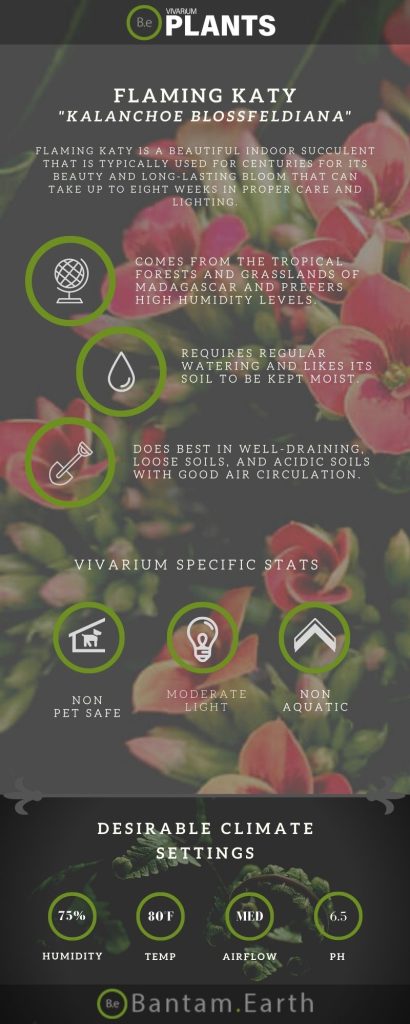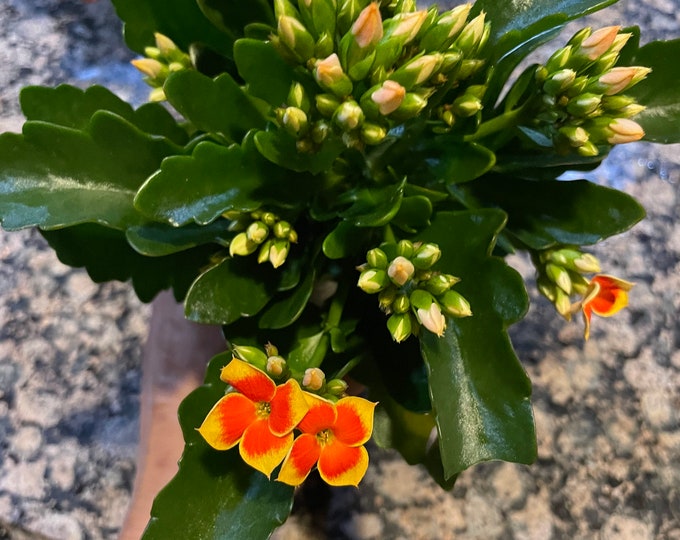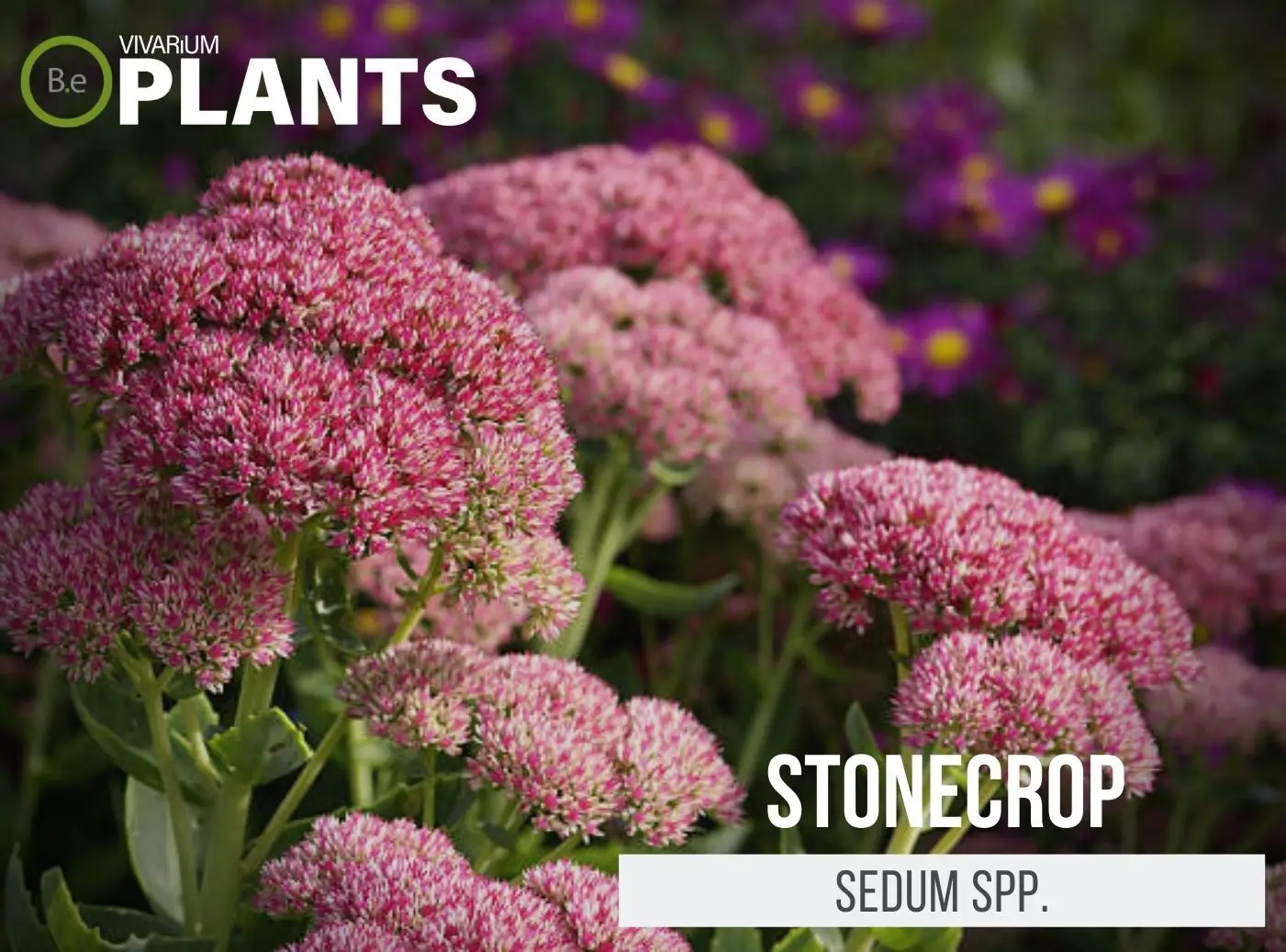Kalanchoe blossfeldiana, also known as flaming Katy, is an excellent ornamental plant native to Madagascar.
Flaming Katy is a beautiful indoor succulent that is typically used to add some life and personality to a vivarium.
This particular plant can make a great addition to the terrarium in part to its very low maintenance needs and unique bloom.
| Quick Stats: | |
|---|---|
| Scientific Name | Kalanchoe blossfeldiana |
| Common Name | Flaming Katy, Florist Kalanchoe, Christmas Kalanchoe |
| Family Name | Crassulaceae |
| Habitat | Madagascar |
| Temperature | 60°F to 95°F |
| Height | Up to 16 inches |
| pH | 6.0 to 7.0 |
| Lighting | Indirect, dispersed |
Table Of Contents:
ToggleWhat is Flaming Katy?
This species has been grown for centuries for its beauty and long-lasting bloom that can take up to eight weeks in proper care and lighting.
Flaming Katy also has a wide range of shaped leaves and sizes, making it a great plant to choose from if you want to provide dimension and structure to the terrarium.


Flaming Katy Facts
The flowers of the flaming Katy usually come in clusters and bloom shades of pink and red, making it a great addition to any vivarium that has a lot of green plants.
Flaming Katy is actually a perennial evergreen, meaning it’ll stay green and in bloom year-round!
Its foliage can also stay vibrant for months to years as well.
Another important fact to keep in mind is the plant’s toxicity to animals.
The Kalanchoe species contains cardiac glycosides, which makes it especially dangerous to cats and dogs.
Description
The flaming Katy’s flowers will form in clusters and create a unique mounding shape that slightly trails down below its main stem.
Its thick, fleshy leaves can come in a variety of shapes, depending on the individual plant, with some shapes ranging from stubby to round to even spade-shaped leaves.
The leaves can range in hue, as much from green and white to dark, deep purples and reds.
Its flowers will range in color, depending on the species, but will primarily bloom shades of light pink with some shades of red.
Habitat
Flaming Katy comes from the tropical forests and grasslands of Madagascar and prefers high humidity levels, at least 65%, with evenly moist soil to thrive.
The temperature in its native environment will range between the high 60s and low 90s.
Flaming Katy also loves to have lots of indirect sunlight and can do great in a bright light room with a window.
pH Preference
Flaming Katy does well in soils with a pH range between 6-7.
If the pH of a terrarium is too acidic, it will affect the number of nutrients and essential elements the succulent can absorb, preventing it from growing or flowering.
It is best to check the pH range of the terrarium before introducing the flaming Katy to ensure the best growth and blooms possible.
Vivarium Type
The flaming Katy is quite an easy-going species.
With that in mind, it will not be too complicated when it comes to choosing the type of enclosure it is grown in.
It is best to try and replicate the plant’s natural habitat as much as possible.
Doing so will make it easier to provide this succulent plant with its basic needs.
The proper setup and theme of the enclosure will make a big difference to the overall look and health of the plant.
Here are recommended vivariums it will do well in:
-
- Terrariums – Fully terrain-based enclosures with little to no aquatic features.
Vivarium Placement
Flaming Katy is a great fit for many terrariums and can fit a variety of themes.
Since this plant loves partial sun, it should be placed in the terrarium near the top portion if you want it to get some of that indirect light.
However, since this plant may rot when exposed to too much sunlight, make sure it’s not in an area that will cause the plant to get too much direct sun.
Substrate
Flaming Katy does best in well-draining, loose terrarium soils, and acidic substrates with good air circulation.
If the soil is too compact or does not drain properly, it can cause the Flaming Katy to rot.
The best substrate for this plant would be a mix of coco fiber, sand, and peat moss, which would make for a great pH-balanced substrate that is light and well-draining.
Lighting
When developing a terrarium with flaming Katy, it is important to understand exactly how much terrarium lighting it needs to stay healthy and look its best.
As long as the light it receives is indirect and dispersed, the Flaming Katy will do just fine in a terrarium.
If the light is too intense, it can cause the plant to burn and sicken.
Buy Flaming Katy
When it comes to buying a flaming Katy plant, there are a few things to keep in mind.
Making sure the plant is healthy when purchased is essential for its success in a vivarium.
Vegetation that is already in poor conditions will have a very hard time adjusting to new environments.
Always make sure to buy from a reliable and honest establishment.
Click the image below to find out more about the current price and other relative info about this plant.
Flaming Katy Care and Propagation
Flaming Katy is a great, low-maintenance plant to keep in your terrarium; it does not require much fertilizing or pruning to stay healthy.
It is however advisable to pinch off any dead or withered leaves and dead flowers, as these will take away from the overall aesthetics.
It can be propagated by taking cuttings of its stems and planting them in damp soil.
How to Grow
Flaming Katy can grow quite quickly if given the right conditions, but it is important to keep the soil well-drained and moist.
It thrives quite well in indirect light and humid conditions, making terrariums a great home for it.
Pinching off the dead leaves and blooms will help new growth appear and aids in the overall health of the plant.
Watering
Due to its succulent nature, flaming Katy does not need frequent watering, however, it does require regular watering and likes its soil to be kept moist.
It should also be noted that the water should not be soaked into the soil as it will cause the roots to rot.
As for temperature and watering preferences, flaming Katy does best in temperatures between 60 and 95 degrees with regular watering.
Plants Similar to Flaming Katy
Adding diversity to an enclosure is key to an aesthetically pleasing setup.
Try mixing up the look of your vivarium with different flora that can easily co-exist in the same types of environment.
Furthermore, if for some reason you find the flaming Katy hard to acquire or would like to consider something similar to this plant…
Here are other plants you might find will do well with or in the place of Kalanchoe blossfeldiana:
Conclusion
Kalanchoe blossfeldiana, also known as flaming Katy, is a perfect low-maintenance plant to add to any terrarium.
It is a versatile succulent that can come in a variety of shapes, sizes, and colors, which can make it suitable for any vivarium type or theme.
Frequently Asked Questions
The kalanchoe plant is typically an indoor plant. It can be grown outdoors in warmer climates, but should be brought inside if temperatures drop below 50°F (10°C).
Yes, kalanchoe plants can be in full sun. In fact, they thrive in direct sunlight and will produce more vibrant blooms if placed in a sunny location.
However, it is important to ensure that the kalanchoe is not exposed to too much sun, as it can cause the leaves to become scorched. If you are growing your kalanchoe outdoors, it is best to provide it with a few hours of direct sunlight each day and keep it in a partially shaded area the rest of the time.
Taking care of a Kalanchoe plant is relatively easy. Here are a few tips to help you keep it healthy and thriving:
1. Water: Water your Kalanchoe thoroughly, but allow the soil to dry out between waterings.
2. Light: Place your Kalanchoe in a bright, sunny spot.
3. Temperature: Kalanchoes prefer warm temperatures, ideally between 65 and 75 degrees Fahrenheit.
4. Fertilizer: Feed your Kalanchoe once a month during the spring and summer with a balanced liquid fertilizer. (BONUS)
5. Pruning: Prune your Kalanchoe to shape it and keep it compact.
Follow these simple steps and your Kalanchoe will be sure to grow healthy and strong!
To keep kalanchoe blooming, you should place the plant in a bright spot that receives indirect sunlight, water it regularly, and fertilize with a balanced fertilizer every two weeks. Additionally, you should pinch off any blooms that have faded to encourage new ones to form.
Yes, dead flowers should be removed from kalanchoe as soon as they start to die. Removing dead flowers will encourage the plant to produce new flowers. When removing dead flowers, make sure to snip them off at the base of the stem. This will help to maintain the health of the plant.




